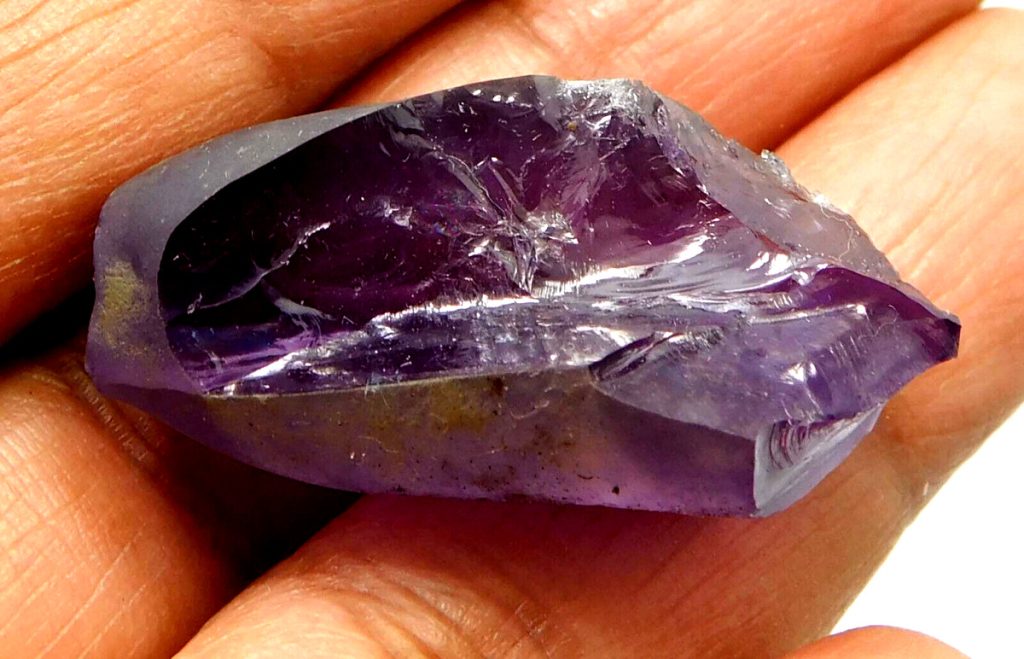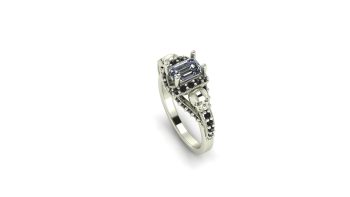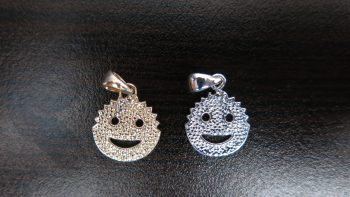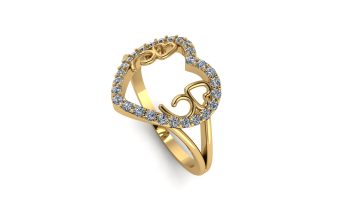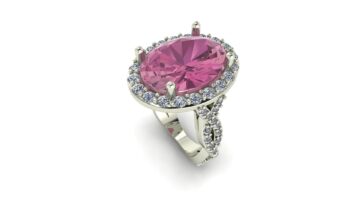Were you or a loved one born in June? If so, then you might want to consider the gift of Alexandrite Jewelry. Alexandrite is one of the more stunning colored gemstones on the planet. With is color change property, it is in a small group of gemstone species where a single stone can show different colors. However, this can make then ridiculously expensive. In fact, nice, natural Alexandrite can cost far more than diamonds per carat. Hopefully, after reading this you will have a good idea about how to go about having a piece of Alexandrite Jewelry made.
What Is An Alexandrite?
An Alexandrite is a rare and valuable gemstone that is known for its remarkable color-changing properties. It was first discovered in the Ural Mountains of Russia in the early 19th century, and it quickly gained popularity among gemstone enthusiasts. The unique feature of Alexandrite is its ability to change color depending on the lighting conditions. In natural daylight, it appears green or bluish-green, while under incandescent light, it transforms into a vibrant shade of red or purplish-red. This phenomenon, known as the “Alexandrite effect,” is caused by the presence of chromium and other trace elements in the gemstone’s crystal structure. Due to its scarcity and mesmerizing color-changing abilities, Alexandrite is highly sought after by collectors and jewelry connoisseurs around the world.
In addition to its captivating color-changing properties, Alexandrite is also known for its exceptional hardness and durability. It ranks 8.5 on the Mohs scale, making it a suitable gemstone for everyday wear. Its strong resistance to scratching and chipping ensures that it can withstand the rigors of daily life without losing its beauty and luster. Alexandrite is often used in various types of jewelry, including rings, earrings, necklaces, and bracelets. Its versatility and timeless appeal make it a popular choice for both formal occasions and everyday wear.
History Of Alexandrite
Alexandrite is a fascinating gemstone with a rich history, albeit short. Only discovered in 1830, it was named after the Russian tsar Alexander II. Alexandrite quickly gained popularity and became highly sought after by collectors and gem enthusiasts. Today, it remains a prized gemstone due to its rarity and unique beauty.
The rarity of Alexandrite further adds to its allure. Genuine Alexandrite is considered one of the most valuable and sought-after gemstones in the world. Its scarcity, combined with its mesmerizing color-changing ability, makes it highly prized by collectors and gemstone enthusiasts alike.
Alexandrite Range of Colors
The Alexandrite Range of Colors is a unique and captivating phenomenon in the world of gemstones. Named after the Russian tsar Alexander II, who first discovered it in the Ural Mountains in the 1830s, Alexandrite is renowned for its remarkable color-changing properties. This mesmerizing gemstone displays a vivid green hue in daylight or fluorescent light, but magically transforms into a rich red or purplish-red shade under incandescent light or candlelight. The Alexandrite’s range of colors also includes variations between these primary colors, such as teal, blue, and pink, making it a truly versatile and enchanting gemstone.
The color-changing ability of Alexandrite is due to its unique chemical composition. It is a form of chrysoberyl. The presence of trace elements are responsible for the gemstone’s distinct color-changing properties. When exposed to different light sources, these trace elements absorb and reflect light in varying ways, resulting in the fascinating color shift.
The unique color of Alexandrite is attributed to the presence of chromium in its crystal structure. This trace element absorbs certain wavelengths of light, causing the gemstone to exhibit different colors under various lighting conditions. This remarkable phenomenon, known as the “alexandrite effect,” is what gives this gemstone its captivating and enchanting allure.
The color-changing nature of Alexandrite is a result of its remarkable optical properties. This gemstone belongs to the chrysoberyl family and is characterized by its strong pleochroism. Pleochroism refers to the ability of a crystal to exhibit different colors when viewed from different angles. Alexandrite’s crystal structure allows light to be absorbed and transmitted differently depending on the direction it is traveling. As a result, the gemstone displays different colors when viewed from different angles, further enhancing its mystique and allure.
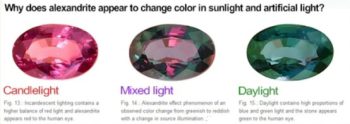
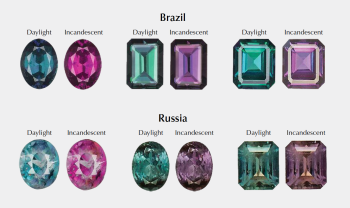
Alexandrite Physical Properties
Alexandrite’s physical properties contribute to its unique appearance and desirability. Alexandrite has a hardness of 8.5 on the Mohs scale, making it a durable gemstone suitable for everyday wear. It has a refractive index of 1.745-1.755, giving it excellent brilliance and sparkle. Additionally, Alexandrite has a specific gravity of 3.70-3.78, which is slightly higher than most other gemstones. These physical properties combine to create a gemstone that is not only visually stunning but also durable and long-lasting.
Natural vs Lab Grown Alexandrite
Alexandrite is formed naturally in the earth’s crust under specific geological conditions. However, recent advancements in technology have made it possible to create lab-grown alexandrite that closely mimics its natural counterpart.
Natural alexandrite is highly sought after due to its rarity and unique color-changing ability. This gemstone exhibits a mesmerizing shift in color, ranging from green in daylight to red under incandescent light. Its natural formation process takes millions of years, resulting in limited supply and higher prices.
On the other hand, lab-grown alexandrite offers a more accessible and affordable alternative. Created in controlled laboratory environments, these gemstones possess the same chemical composition and physical properties as natural alexandrite. They also display the characteristic color change, making them indistinguishable to the naked eye.
Both natural and lab-grown alexandrite have their own merits. Natural alexandrite holds a certain allure and prestige due to its rarity, making it a prized possession for collectors and enthusiasts. Lab-grown alexandrite, on the other hand, provides an opportunity for more people to enjoy the beauty of this gemstone without breaking the bank.
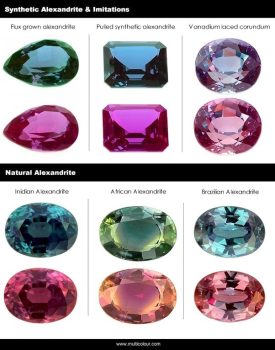
Beliefs About Alexandrite
Beliefs about Alexandrite vary across different cultures and traditions. In some cultures, Alexandrite is believed to bring good luck and fortune to its wearer. It is also associated with balance and harmony, and is thought to enhance intuition and creativity. Additionally, Alexandrite is often seen as a symbol of transformation and renewal, making it a popular choice for those seeking personal growth and positive change.
Why Alexandrite Jewelry Is In Fashion
Alexandrite jewelry has become increasingly popular in the fashion world. This gemstone, known for its unique color-changing properties, adds a touch of elegance and sophistication to any outfit. The mesmerizing hues of alexandrite range from green in daylight to red under incandescent light, making it a versatile and eye-catching choice for jewelry enthusiasts.
One reason why alexandrite jewelry is in fashion is its rarity. This gemstone is incredibly scarce, making it highly sought after by collectors and jewelry connoisseurs. Its scarcity adds to its allure and exclusivity, making it a desirable choice for those who want to stand out from the crowd.
Another reason for the popularity of alexandrite jewelry is its symbolic meaning. This gemstone is believed to bring good luck, fortune, and love to its wearer. Many people choose alexandrite jewelry as a meaningful gift for special occasions such as birthdays, anniversaries, or engagements.
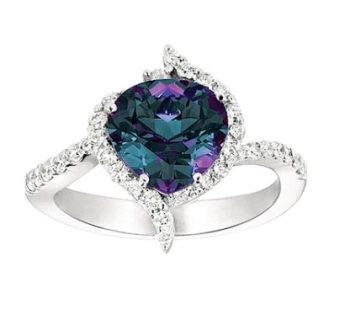
Notable Alexandrite From the Past & Present
Alexandrite, a rare and captivating gemstone, has a rich history filled with notable examples from the past and present. One such remarkable Alexandrite is the “Alexanderite,” a 66-carat gemstone discovered in the Ural Mountains of Russia in the 19th century. Its mesmerizing color-changing properties and exceptional clarity make it a true gemological treasure.
In the present day, another noteworthy Alexandrite is the “Gem of the Sun,” a stunning 23-carat gemstone found in Brazil. This remarkable gem exhibits a vibrant green hue in daylight, but transforms into a deep red under incandescent light. Its unique color-changing phenomenon continues to captivate gem enthusiasts and collectors alike.
These notable Alexandrite gems serve as a testament to the beauty and rarity of this extraordinary gemstone. Whether from the past or present, Alexandrite continues to enchant and fascinate with its remarkable color-changing properties, making it a truly remarkable gem in the world of gemology.
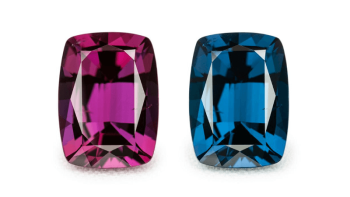
How To Care For Alexandrite Jewelry
Alexandrite jewelry requires special care to maintain its beauty and durability. Firstly, it is important to store your alexandrite jewelry separately from other pieces to prevent scratches and damage. When cleaning, use a soft cloth and mild soap to gently wipe the surface. Avoid using harsh chemicals or abrasive materials that could harm the gemstone. Lastly, it is recommended to have your alexandrite jewelry professionally inspected and cleaned at least once a year to ensure its longevity. By following these care tips, you can enjoy your alexandrite jewelry for years to come.
What Does Alexandrite Cost?
Alexandrite, a rare and exquisite gemstone, comes with a price tag that reflects its uniqueness. The cost of Alexandrite can vary depending on several factors. These factors include the size, quality, color, and origin of the gemstone. Generally, Alexandrite can range from a few hundred dollars per carat to several thousand dollars per carat. It is important to consult with a reputable jeweler or gemstone expert to get an accurate estimate based on your specific requirements.
The size of the Alexandrite gemstone plays a significant role in determining its cost. Larger stones are generally more expensive than smaller ones due to their rarity. Additionally, the quality of the gemstone, including its clarity and cut, can also affect the price. Alexandrite with minimal inclusions and a well-executed cut will command a higher price.
The color of Alexandrite is one of its most distinctive features. This gemstone exhibits a remarkable color-changing property, appearing green in daylight and red under incandescent light. The more vibrant and intense the color change, the more valuable the Alexandrite becomes. Origin also plays a role in determining the cost, with Russian Alexandrite often being the most sought after and therefore more expensive.
Let Us Create Your Alexandrite Jewelry
We create custom jewelry. And that is just about to do. We make it to order as well. This means that we keep no inventory and create each piece specifically for that person. It also means that we choose each stone for each project. So, we can pick the perfect stone for you out of all that are available on the market. This is unlike a retail chain jewelry store where you will be limited to what they have in stock.
You can view our portfolio of custom engagement rings or custom pendants to look for ideas. Or you can contact us with your own idea.. You know what they (we) say. Once you go custom, you never go back. To the mall!
